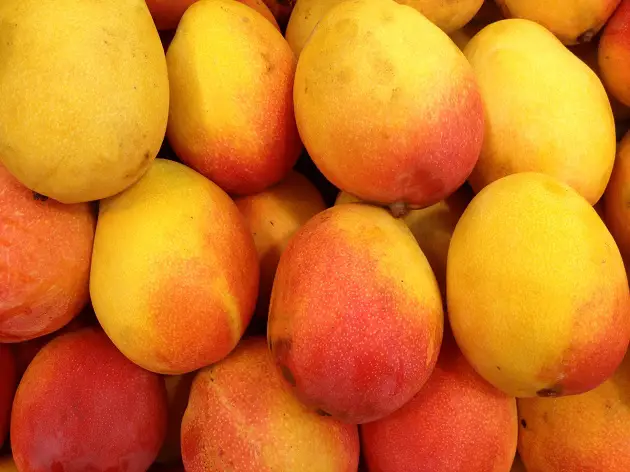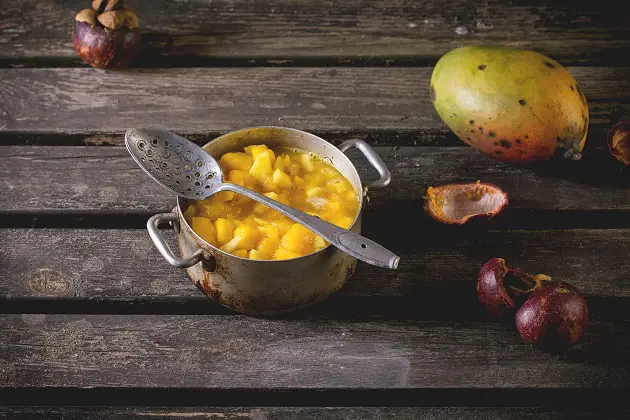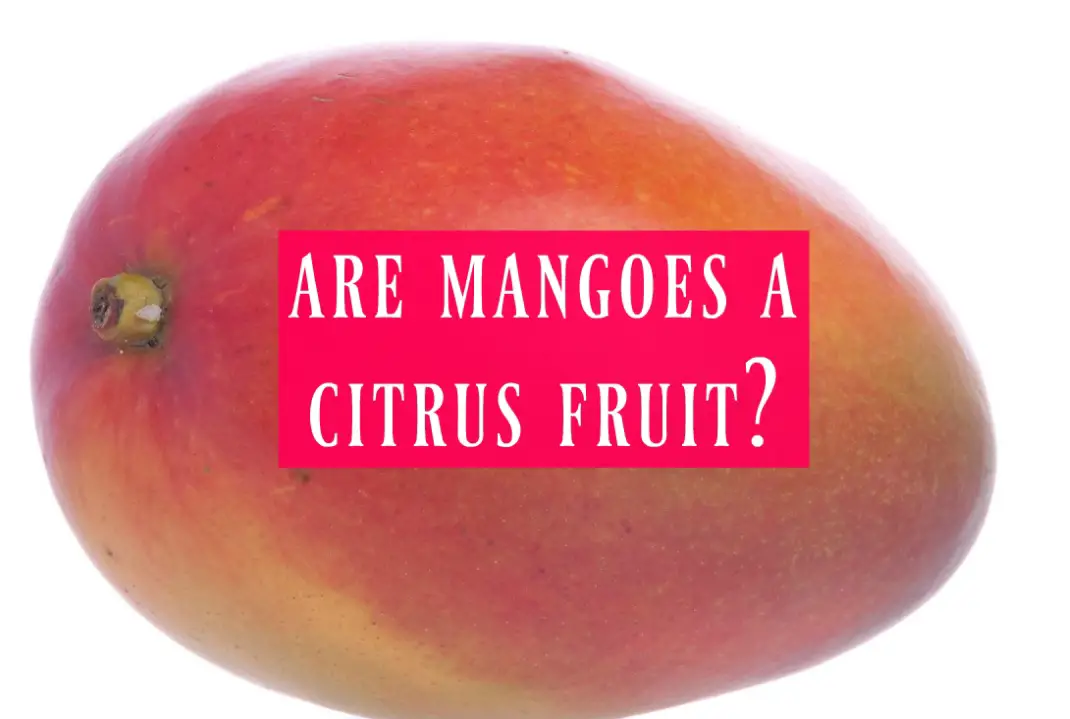How much do you know about mangoes? Have you ever tasted one?
Do you know about the multitude of nutritional benefits the mango can provide?
Let’s take a closer look at this extraordinary fruit. We’ll discuss what a mango looks and tastes like, what type of fruit it is, and how mangoes can improve overall health and wellbeing.
Quick facts
- mangoes are round, oval, or kidney-shaped
- they contain no fat, cholesterol, or sodium
- mangoes are NOT a citrus fruit
What is a mango?
Mangoes are a juicy stone fruit, meaning the flesh of the fruit surrounds a stone or pit in the center.
Generally, mangoes are round, oval, or kidney-shaped. Their smooth, waxy outer skin varies in color and is typically a combination of yellows, greens, oranges, and reds.
The smallest mangoes are plum-sized while larger varieties can weigh four to five pounds.
The mango is native to South Asia and other tropical regions. Most mangoes that are imported into the United States come from Mexico, Peru, Ecuador, Brazil, Guatemala, and Haiti.
Within the US, a small number can be successfully grown in California and Florida.
Think back to eighth-grade biology and the scientific classification system. Mangoes are in the Sapindales order, which means they are a flowering plant or shrub.
Surprisingly, mangoes belong to the Anacardiaceae family, which includes cashews, poison ivy, and poison sumac.
This explains why some people experience an adverse reaction after handling mango skins, leaves, and stems.
What does a mango taste like?

A ripe mango tastes juicy and sweet with a hint of spice.
Some people compare the mango with a peace or pineapple. Occasionally, mangoes have a turpentine or piney taste and a stringy, fibrous texture.
This has to do with the ripeness of the fruit, as well as its growing conditions.
Are mangoes a citrus fruit or a tropical fruit? Is there a difference?
Citrus Fruits
Let’s briefly discuss citrus fruits. They are native to tropical and subtropical regions.
Scientifically, they are Sapindales, but they belong to the Rutaceae family.
Citrus fruits like;
- Oranges
- Lemons
- Limes
- and grapefruit
are typically round.
Their inner pulp is perfectly divided into several segments. This pulp contains large amounts of citric acid which can make the fruit taste sweet or sour.
Mangoes are not a citrus fruit.
Tropical fruits
Tropical and subtropical fruits are those that have their origin in tropical and subtropical areas.(1) They are an evergreen tree or shrub.
True tropical fruits cannot tolerate cool temperatures and frost, while some subtropical fruits (like oranges) can withstand occasional brief dips in temperature.
Both mangoes and citrus fruits are considered tropical. However, mangoes require true tropical growing conditions, while most citrus fruits can thrive in subtropical areas as well.(2)
Health benefits of the mango
From a nutritional standpoint, one cup of mango contains 100 kilocalories.(3)
Mangoes provide a wide range of vitamins, minerals, and antioxidants. Looking at the recommended daily allowances for vitamins and minerals, one serving provides 100% of recommended vitamin C, 35% of vitamin A requirements, and 12% of total fiber intake.
Furthermore,
mangoes contain no fat, cholesterol, or sodium.
The mango: more than just a fruit

In many tropical areas, especially those with limited resources, the mango is used for so much more than eating.
The pulp, seeds, and skin, as well as the leaves and bark of the mango tree, all have medicinal purposes. Asthma, wounds, diarrhea, heat stroke, indigestion, and several other maladies are treated with various parts of the mango or mango tree.
According to a literature review conducted in 2010, mangoes may help control blood sugar, lower blood pressure, reduce fevers, and promote healthy digestion.(4)
They are also thought to possess antibiotic, anti-fungal, anti-viral, and anti-parasitic properties, just to name a few.
Mangoes contain powerful antioxidants which may help prevent colon, breast, leukemia, and prostate cancers.
Other benefits of the mango include improved memory and concentration and lower cholesterol levels. Sliced mangoes can even be placed on the skin to help unclog pores and treat acne breakouts.
A glimpse at the current research
Mangoes may be helpful in irritable bowel syndrome
A study released by the College of Agriculture and Life Sciences at Texas A&M University (2018) found that eating 200 to 400 grams per day of fresh or frozen mango helped lower the severity scores of participants’ IBS symptoms.(5)
It also improved healthy bacteria in the gut.
More research is needed due to the small scale of the study, but results were very positive.
Mangoes may reduce high blood pressure and promote healthy digestion
Another study published by the University of California, Davis (2018) looked at the mango’s influence on the heart and vascular systems of 25 postmenopausal women.(6)
Researchers found that mango consumption promoted favorable changes in blood pressure as well as gut fermentation.
Although larger studies are needed, this study suggests mangoes could be a “heart-healthy” fruit.
How to select and prepare your mango
To choose a ripe mango, squeeze the fruit gently; a ripe mango will give slightly. Also, the stem area should be fragrant.
Do not judge by appearance.
Because of the inner stone, cutting a mango can be challenging at first. Browse online videos for cutting tips.
In conclusion
It’s easy to see why the mango is considered the “king of fruits.”
They provide several healthy vitamins, minerals, and antioxidants. They are also extremely beneficial for their medicinal properties, especially in areas with limited resources and poor access to medical care.
Although both mangoes and citrus fruits are considered tropical fruits, the mango is not a citrus fruit.
If you are looking for a delicious fruit with loads of nutritional value, choose a mango!
Resources
(1)https://www.encyclopedia.com/food/encyclopedias-almanacs-transcripts-and-maps/tropical-and-subtropical-fruit
(2)https://www.crfg.org/pubs/ff/mango.html
(3)https://www.mango.org/mango-nutrition/
(4)https://www.ncbi.nlm.nih.gov/pmc/articles/PMC3249901/
(5)https://www.mango.org/wp-content/uploads/2018/04/Inflammatory_Bowel_Disease_Final_Report_Eng.pdf
(6)https://www.mango.org/wp-content/uploads/2018/04/Cardiovascular_Study_Final_Report_Eng.pdf
Leave Feedback: Was this article helpful?

